This post is very special to me in many ways. The recipes in this post are apt for this month – Chaitra maasa / Chitirai thingal. As usual when mom and I were discussing what else we can put up for the thali series, mom [as usual] recollected a special custom that is performed during this month. Later, I called up my grandpa and asked him the details.
My grandpa is going to be 90 this month! He is an orthodox person who performs poojas and is quite religious. My grandparents still follow certain customs that have been long forgotten. These customs have health significance and since our ancestors wanted every one to follow it for a healthy living, named them as religious procedures, making it a compulsion. But these days many of us are put off by the term ‘religious procedures’ or don’t have time to follow them!
So when I spoke to grandpa a couple of days ago and told him I was going to write about some special thali he was as enthusiastic as I am and immediately gave me the procedures and the details for this post.
So presenting to you today, the thali that is prepared during the chaitra maasa’s Panaka pujay.
Chaitra maasa is the first month of the Hindu calender and is followed in many regions in India. It is believed that that Lord Brahma created the Universe on this day and hence it is regarded as the first day of the Universe.
Before going to the actual post, here are some general things that are performed during this month. Throughout this month, a pot filled with water should be given as dhaana /
kind of donation to others. If it is not possible to give it on all days, at least one such pot must be given this month.
Similarly during this month, vedic scholars are invited home in the afternoon, sometime between 3-4pm. It has to be performed before 5pm. As soon as they arrive, their feet are washed. The lady of the house holds the pot of water pouring it gently into the cupped hands of the husband who holds them over the feet of the guests.
The guests are seated on straw mats and banana leaves are spread in front of them. Dishes that are apt for this pooja are prepared and served.
Now let us see the dishes that find their place in this panaka pujay.
Dishes
Kesari – A delicious dessert made from semolina, sugar and ghee
Kosambari – seasoned lentils
Gojjavalakki / hunisayhannu avalakki – Tamarind flavored pressed rice
Mosaravalakki – Pressed rice seasoned and soaked in yogurt
Beverages
Neer more – Seasoned buttermilk
Panaka – A concoction of jaggery, ginger powder and cardamom
Tender coconut water
Sonti bella – It is a digestive that is prepared with powdered ginger, jaggey and ghee.
Fruits
Seasonal fruits like mango, jackfruits are also served.
This time when I wanted to make this thali, I could not find mangoes! Yes, it is supposed to be in season now but I was told that mango crophas gone down this year. The places that are famous for mango cultivation has produced very less mango and maybe they were are sent away for exporting.
Anyway, I was not able to find any decent looking mango and those shops which boasted of selling mangoes had something that did not even resemble a mango! They were so small and shriveled!
So I have used the other fruits like guava, sapota, grapes and banana.
After the meal they wash their hands. Later they are seated and given thamboola. Thamboola consists of betel leaves,betel nuts, bananas, dhakshanay[money].In this thamboola there are certain specifications too. Betel leaves must be placed in even numbers. So are the betel nut and banana. In olden days, INR 1.25 was kept as the , dhakshanay. But nowadays since it has no value, the amount placed depends on the capacity of the person giving it off. But it should be one of the following- INR 11 / 51 / 101/ 501 / 1001 etc. The people in the household fall at the feet of the scholars and receive their blessing
What is the significance of doing all this you may ask? Let me explain…
The dishes that are prepared for this pooja are having high nutritive value. The pressed rice, jaggery used in the dishes is rich in iron. The curd used in pressed rice recipe , neer more, panaka, kosambari, tender coconut are all body coolants .Fruits are rich in vitamins and minerals. More over since they are seasonal fruits, they are not expensive.
Food is one thing that makes people happy and it is the only thing in the world that satisfies the senses of man. No one can keep on eating no matter how delicious the food. A person says ‘No’ only to food as he can never be satisfied with other worldly things.When his tummy is full he is happy and the person who serves the food is also happy.
In our scriptures, serving each of these things have a special meaning. It is said to give us blessings and free us from karmas [ an action whose effect is experienced as a future consequence].
These days, not many perform this panaka puja at home. Some temples in South India perform this puja in their premises during Sri Rama Navami. Those who like to perform this pujay can pay the puja fee and partake in it. Before offering these dishes to the scholars, they are offered to God as Neivedhyam[sacred offering]
It took us[mom and I] 2 whole hours to get the recipes ready for this post. These dishes are very healthy.The credit for this post goes to my dear grandpa for sharing this wealth of knowledge with me and to mom who prepared the majority of the dishes for this post.Here is the post for today – Neer more
Hope you enjoyed this thali…
Check out the Blogging Marathon page for the other Blogging Marathoners doing BM#15
This is off to Srivalli’s Thali mela
Bon Appetiti…
Post Views: 5,284

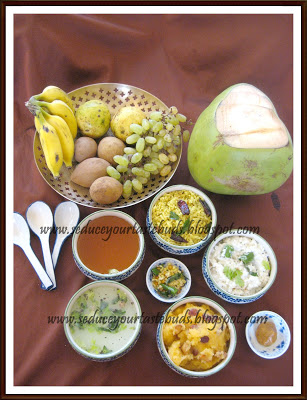
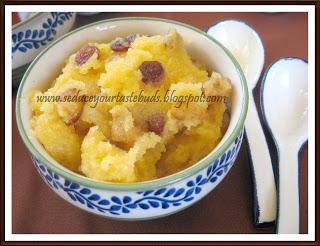
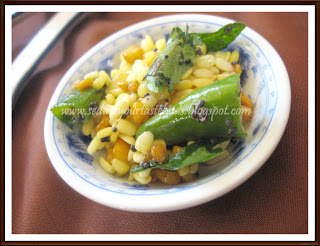
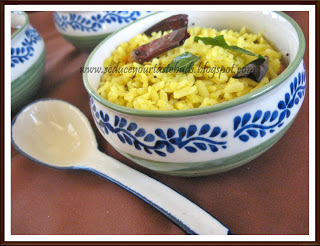
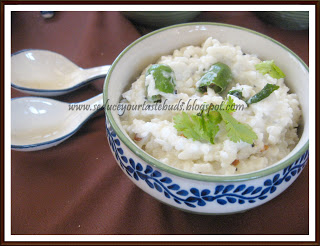
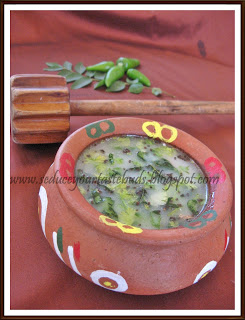
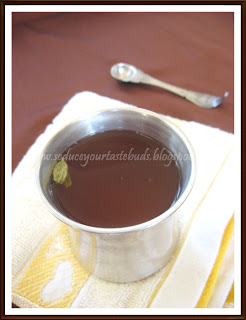
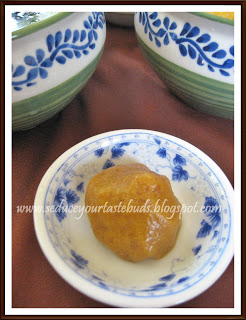
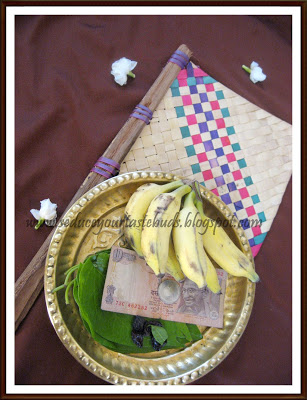
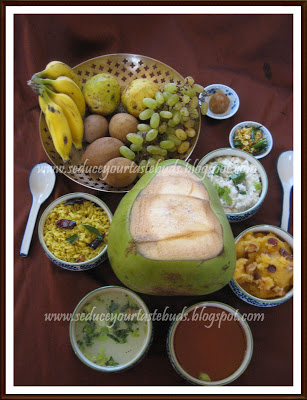
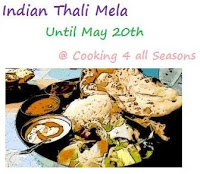

wow – I LOVE learning about the history and cultural traditions!
This puja is new to me. I am sure there must be a similar pooja or ritual that is performed in AP too, that I am unaware of. Thanks to you & your grandpa for sharing this information.
Superb write-up PJ…we follow similar tradition and it just confirms my thought that all customs and traditions from different states kind of convey the same message. Great to know from your grandfather and I feel that by itself is a pleasure to read. Love the dishes in the thaali …good one PJ.
Wow that was really great to know about the chithra maasa pooja. Having old people at home I fell is always a blessing. Because they have plenty of good things to be shared with… Thanks for sharing the customs we followed in olden days…
pj ..what information!!…my my..I am absolutely unaware of any such customs and poojas…I am impressed!!..trust me simply amazed by your knowledge on these….and lovely pics..very neat and cool.Thanks for sharing:)
What a wonderful and informative post PJ..as I told you, it's a treasure..thanks for sharing it..so glad for the entry..:)
Everyday we are learning some many things from ur post PJ,super deicious spread, enjoyed ur write up..
Great writeup and very nice info !!!! Wonderful collectionof dishes !!!!
excellent and informative write up. I was also preparing a post with similar items!
Awesome write up PJ. Thanks for sharing the traditional thali.
I remember in my native,they make thses…luv the panagam so much..
i had no clue of this too.. its really nice to know why & how they perform such rituals.. Very nice post yet again! Gojju avalaki is my fav hough 🙂
Ongoing Event : WTML
Thanks to your Grandpa and you for the info and the nice thali.
The thali looks absolutely stunning! Two hours seem less to prepare so many dishes.
Love our traditions, so much of information behind each n every pooja and vratham!!! Very informative and true treasure post pj!!!!
Connecting back to our roots and bringing back the forgotten cultural traditions is not an easy task… Great post and hats off to you!!
Krithi's Kitchen – Serve It – Pressure Cooked/Slow Cooked
very new to me….awesome